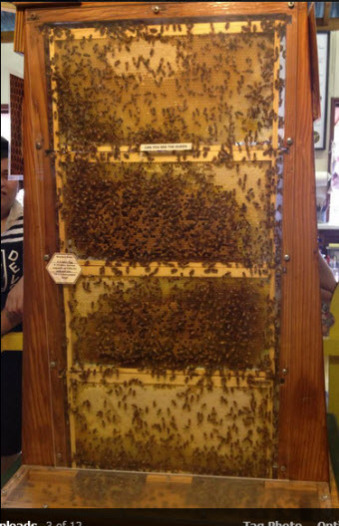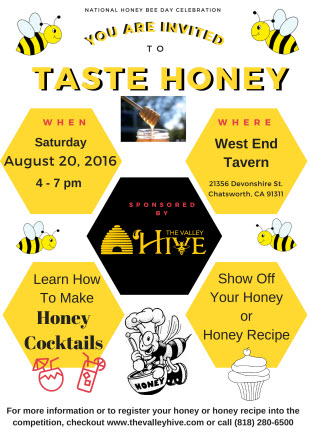Visit the Bee Booth at the LA County Fair - Now Thru Sept. 30 (Wed - Sun)

Watch the bees bring in nectar to make Honey!!!
How Do Bees Make Honey?
Honey is the sweet fluid produced by honey bees from the nectar of flowers. Worker honey bees transform the floral nectar that they gather into honey by adding enzymes to the nectar and reducing the moisture.
What is Raw Honey?
While there is no official definition of raw honey, it generally means honey that has not been heated or filtered.
Why is most honey filtered?
According to USDA Grading Standards for extracted honey, filtered honey is honey that has been filtered to the extent that all or most of the fine particles, pollen grains, air bubbles, or other materials normally found in suspension, have been removed.
Honey that is filtered by packers is filtered for various reasons:
1. Many consumers prefer honey that is liquid and stays liquid for a long time.
All honey crystallizes eventually. Suspended particles and fine air bubbles in honey contribute to faster crystallization. Filtering helps delay crystallization, helping the honey to remain liquid for a much longer period than unfiltered honey.
2. Many consumers prefer honey to be clear and brilliantly transparent.
- The presence of fine, suspended material (pollen grains, wax, etc.) and air bubbles results in a cloudy appearance that can detract from the appearance. Filtering is done to give a clear brilliant product desired by consumers. For the filtered style of honey, USDA Grading Standards for Extracted Honey give higher grades for honey that has good clarity.
- Honey is filtered to remove extraneous solids that remain after the initial raw processing by the beekeeper.
Various filtration methods are used by the food industry throughout the world. Ultrafiltration, a specific kind of filtration used in the food industry, should not be confused with other filtration methods generally used in the honey industry. When applied to honey, ultrafiltration involves adding water to honey and filtering it under high pressure at the molecular level, then removing the water. It is a much more involved and expensive process which results in a colorless sweetener product that is derived from honey but is not considered “honey” in the U.S.
Honey that is filtered through more traditional methods is still “honey,” even if pollen has been removed along with other fine particles.
For more information on filtration and pollen’s role in honey, click here.
 Why does my honey look/taste different than I'm used to?
Why does my honey look/taste different than I'm used to?
Honey comes in many colors and flavors - these are called honey varietals and they are determined by the type of flowers the bees visited for nectar. Some are light and sweet; others are dark and bold. Pick the honey you like and enjoy!
Honey’s Nutritional Profile!
Honey is composed primarily of carbohydrates (natural sugars) and water, as well as trace enzymes, minerals, vitamins, and amino acids. Providing 17 grams of carbohydrates and 64 calories per tablespoon, honey is an all-natural sweetener without any added ingredients.
Generally, darker honeys have higher antioxidant content than lighter honeys.
For a complete nutrient listing, please visit USDA’s National Nutrient Database at:
http://www.nal.usda.gov/fnic/foodcomp/search/.
For more information on filtration and pollen’s role in honey, click here.
Why can’t I feed honey to my baby less than 1 year of age?
Honey may contain Clostridium botulinum spores that can cause infant botulism - a rare but serious disease that affects the nervous system of young babies (under one year of age). C. botulinum spores are present throughout the environment and may be found in dust, soil and improperly canned foods. Adults and children over one year of age are routinely exposed to, but not normally affected by, C. botulinum spores. Honey is safe to consume during pregnancy and lactation. While infants are susceptible to the infant botulism, adults, including pregnant females, are not. The concern for babies stems from the fact that infants lack the fully developed gastrointestinal tract of older humans. Since the mother is not in danger of developing this condition, the unborn baby is protected. Spores are inactivated when manufactured food products (such as cereals or nuts) receive a roasting heat treatment. Graham crackers or cereal, for example, would not contain any viable microbial spores.
The above information is from the National Honey Board: http://www.honey.com
Photography by Kodua Galieti!
Visit the LA County Fair!!!! BUZZ BY - SAY HI!!! Pick up some LOCAL RAW HONEY!!!
 The Valley Hive - 1st Honey Tasting and Recipe Contest in Celebration of National Honeybee Day.
The Valley Hive - 1st Honey Tasting and Recipe Contest in Celebration of National Honeybee Day.










